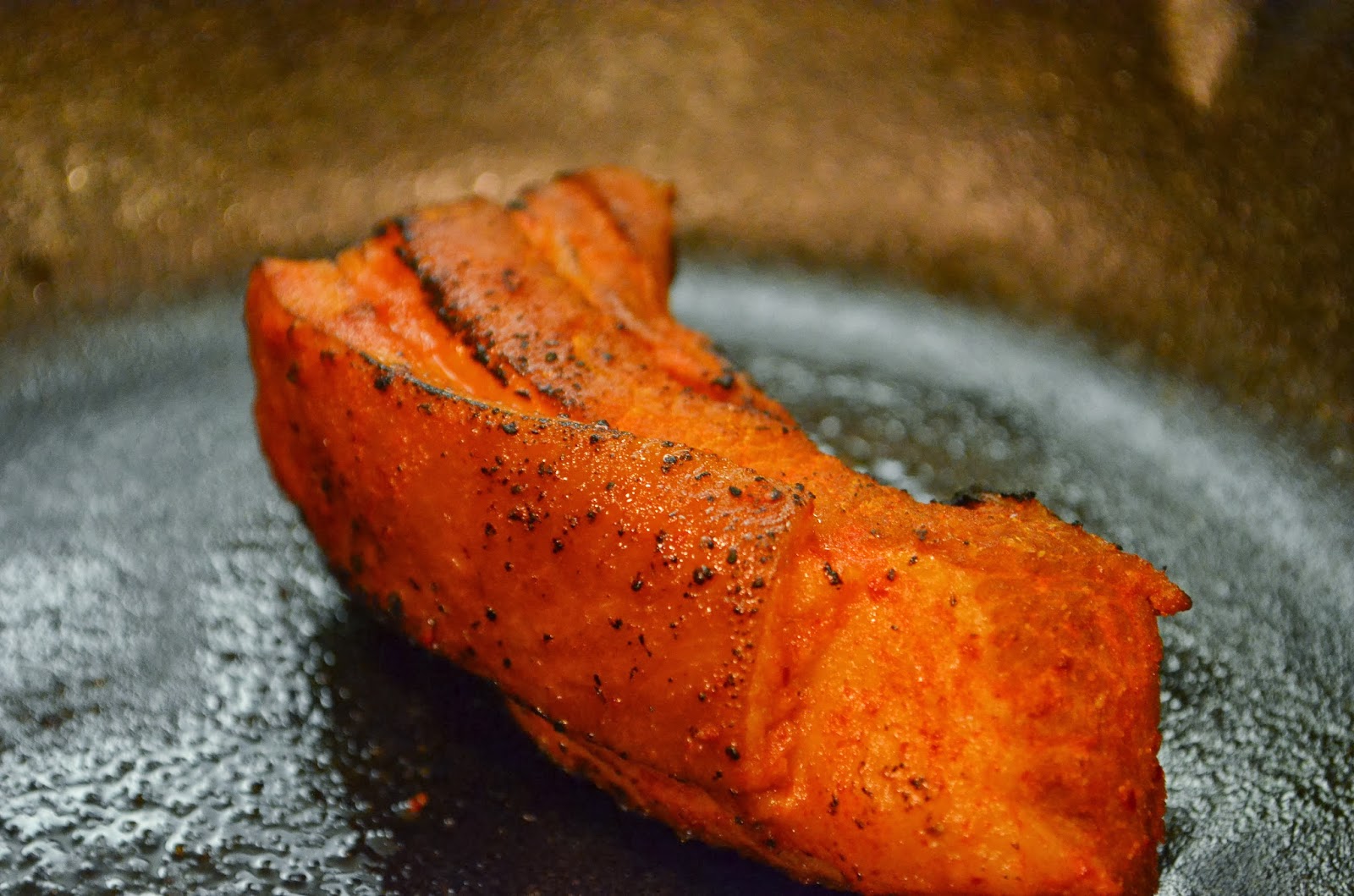But then there is pork belly. Asians have figured out it is one of the tastiest things on the planet. I remember vividly when I had it for the first time, being somewhat suspicious of eating braised bacon. Then I learned that the texture was outright screaming awesomeness.
I have been experimenting with braising pork belly Korean style, and the results have been good enough that I "keep experimenting". When a sous vide circulator joined our kitchen arsenal, pork belly was on the short list of things to try. Let me describe first the sous vide approach, and then mention what to do if you have not splurged for a water oven.
First, you need pork belly. The meatier the better, and around here this means a trip to HanKook, the top Asian market in South Bay. I think I used about 1.5 to 2lb of pork belly. Pork belly likes to bathe in a pool of spices before one cooks it. I used about 2TB dried Korean red pepper powder, and about 2TB of Korean chili paste, about 1 TB or so of garlic powder, a good sprinkling of salt, say 1tsp or so, about 1TB of sesame oil, and about 2 TB of rice vinegar. I mixed the spices in a plastic bag, added pork belly that I cut into three chunks to fit the bag nicer, and then I vacuum-sealed the bag.
 |
| Pork belly after 48 hours at 144F |
I let the pork belly marinate in the fridge for about a day. At least a few hours is the minimum.
I cooked pork belly in 144F water bath for 48 hours. A couple of hours more or fewer doesn't make any difference, so no need to panic if it is 10pm and you want to eat pork belly in two days for an early supper.
After 48 hours, the pork belly looks kind of odd. It is not obvious it is cooked, yet it is quite clear that it is not raw. I am a bit sad I didn't take a picture of the pouch in which the pork belly was cooked. You could see that a good amount of fat, but not all, got rendered out. Will it be dry?
 |
| Torched pork belly looks much more appetizing |
 I tend to torch things in a cast-iron skillet. It is very unlikely the skillet will catch fire. A wood cutting board is a surprisingly good choice as well.
I tend to torch things in a cast-iron skillet. It is very unlikely the skillet will catch fire. A wood cutting board is a surprisingly good choice as well.Once the pork belly looks that good, the only thing one can really do is slice it and consume it promptly. I seasoned the sliced pork belly with a touch of sesame oil, and I served it with a 50:50 mixture of brown rice and black rice, that I cooked slowly in vegetable stock. Then I got adventurous and added a few slices of avocado. The effect was shockingly sublime. The rice had a touch of chewiness to it, the avocado was is usual buttery-yet-somewhat-plain self, and the pork belly had just enough of spiciness to it that it paired beautifully with avocado and rice. I was not sure about the interaction of two very rich and smooth textures, but it turned out that avocado helped the pork belly reach the full potential of melting in your mouth.
As much as I like pork belly, I can only consume a few slices. What should one do with leftovers? I only torched the pork belly that I was about to slice, and the rest found itself in a plastic container in our fridge. When I wanted to consume the rest, I could have re-heated it in a sous-vide bath to 130F, and then I would repeat the pyrotechnic exercise. I was more in a hurry, so simply sliced the meat and reheated it in at a medium heat in a cast-iron pan. As long as you don't overheat it, the deliciousness will stay around.
 |
| Pork belly braised in the oven and then crisped in a pan |
In the meanwhile prepare the braising liquid. I like to use tomato paste dissolved in a 2-3 cups of water, some red wine, garlic, and the omnipresent Korean red pepper powder, a tablespoon or so. Add a tsp or so of salt. Do taste the liquid to see what it does for you! Optionally you can add some sugar and soy sauce, just make sure you adjust the amount of salt if you use soy sauce. Add the pork to the braising liquid, bring to simmer, and braise in the oven at 325F for 2 hours or until fork tender. Or simply have it simmer on the stove top for 2h or until fork tender.
Before serving, dry the pork belly with a paper towel and either crisp it up in a hot oven, or perform my favorite activity and torch it. I like torching because it crisps the surface, but the heat does not penetrate deep as it does in the oven. You can also crisp the meat in a hot cast-iron pan.
Pork belly cooked the traditional way will melt in your mouth and you will be temporarily transported to taste-bud heaven. Sous vide, however, elevates that to a level I was not aware existed until I gave it a try.
No comments:
Post a Comment